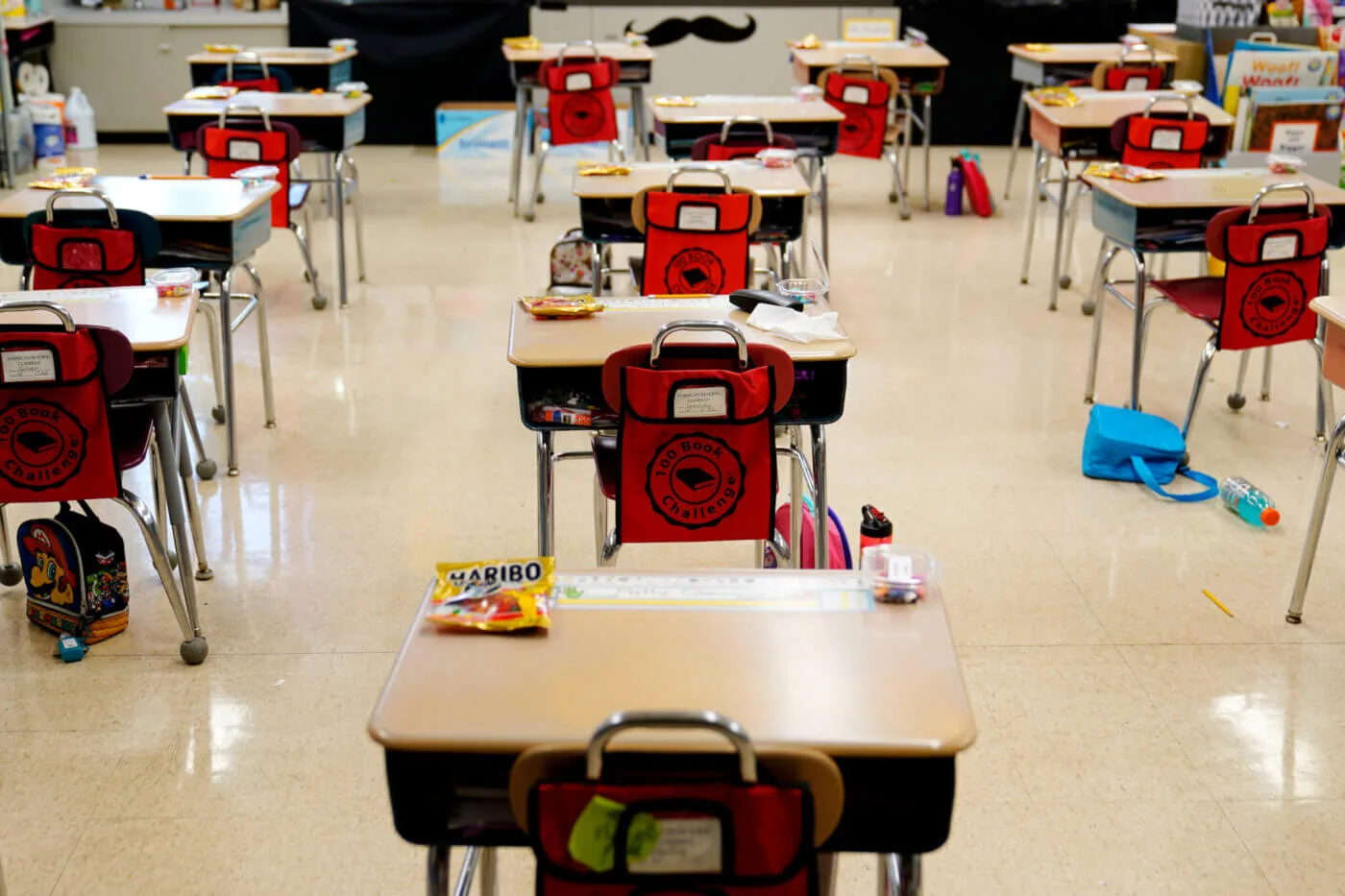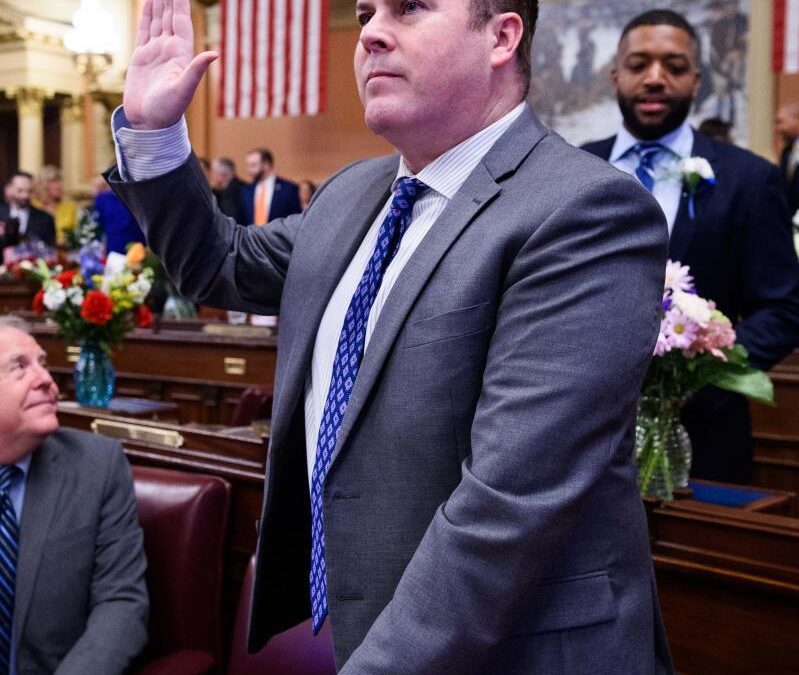
Desks are arranged in a classroom at Panther Valley Elementary School, Thursday, March 11, 2021, in Nesquehoning, Pa. (AP Photo/Matt Slocum)
In her decision, Commonwealth Court Judge Renee Cohn Jubelirer said “students attending low-wealth districts are being deprived of equal protection of law.”
HARRISBURG — A Pennsylvania judge ruled Tuesday the state’s funding of public education falls woefully short and violates students’ constitutional rights, siding with poorer districts in a lawsuit that was first launched eight years ago in pursuit of potentially billions of dollars in additional annual support.
Commonwealth Court Judge Renee Cohn Jubelirer found that the state has not fulfilled its obligations to the poorest public schools under the state constitution. She said in a nearly 800-page ruling that current funding violates those students’ rights to what should be a “comprehensive, effective, and contemporary” system.
The Public Interest Law Center and the Education Law Center, which helped represent the plaintiffs, hailed the decision as “a historic victory for students,” saying it will “change the future for millions of families.”
Trial proceedings began in November 2021 and lasted 48 days, with 41 witnesses and 1,100 exhibits generating 14,600 pages of testimony.
Cohn Jubelirer wrote that students in areas with low property values and incomes “are deprived of the same opportunities and resources as students who reside in school districts with high property values and incomes,” and that disparity “is not justified by any compelling government interest nor is it rationally related to any legitimate government objective.”
She said the result is that students in lower-wealth districts are being deprived of their constitutional right to equal protection of law.
Roughly 52% of Pennsylvania’s students get their education in underfunded school districts.
Lawyers for the school districts and others who sued presented evidence during last year’s trial that schools are underfunded by $4.6 billion, an estimate that they say does not account for gaps in spending on special education, school buildings and other facilities.
At its heart, the lawsuit argued Pennsylvania’s method of paying for public schools did not meet an explicit standard in the state constitution that lawmakers provide a “thorough and efficient system” of education.
The state contribution to local school district costs ranks very low compared to other states. According to the most recent annual report from the Pennsylvania School Boards Association (issued in May 2022) Pennsylvania currently ranks 45th nationally for state public school funding, at 37.9%. That number is a bit deceptive, however, because the rest of the money comes from local taxes, which creates a huge gap between rich and poor districts. In a poor district like Reading, Berks County, the state’s contribution may actually be 72% of district funding; in wealthy New Hope-Solebury, the state’s contribution only makes up 15% of the district funding. The difference depends on what local taxpayers contribute.
Republican leaders in the General Assembly had told the judge school subsidies were adequate and growing. Republican leaders in the state House and Senate indicated the decision was being reviewed.
Cohn Jubelirer found that achievement gaps are wider for certain historically disadvantaged groups, including Black students, Hispanic students, English-language learners, poorer students and others.
“Educators credibly testified to lacking the very resources state officials have identified as essential to student achievement, some of which are as basic as safe and temperate facilities in which children can learn,” Cohn Jubelirer wrote. “Educators also testified about being forced to choose which few students would benefit from the limited resources they could afford to provide, despite knowing more students needed those same resources.”
Cohn Jubelirer’s decision did not direct the Legislature on how much state aid to distribute, or how to distribute it. Rather, she wrote that the court is in “uncharted territory with this landmark case,” and left it to the governor, lawmakers and the school districts that sued to come up with a plan to address the constitutional violations.
As state attorney general last year, newly elected Democratic Gov. Josh Shapiro filed a brief that supported the lawsuit’s aims.
The case was brought by six districts, several parents, the state conference of the NAACP and the Pennsylvania Association of Rural and Small Schools. They sued the governor, Education Department, education secretary, state Board of Education and high-ranking legislative leaders.
The litigants have said Pennsylvania’s state government pays for a far smaller percentage of K-12 education than the national average. Pennsylvania relies heavily on real estate property taxes to fund its public schools, helping cause a wide gap between the state’s richest and poorest districts.
They have argued underfunded districts have been more likely to have larger class sizes, less qualified faculty, outdated textbooks and other shortcomings. But Republican legislative leaders responded that the state’s educational spending compares favorably to other states and that’s reflected in student achievement.
The case had been dismissed by the Commonwealth Court, ruling that school funding was a political question that should not be resolved by the courts, but was revived in 2017 by the state Supreme Court. An appeal to the high court is possible.
Keystone managing editor Patrick Berkery contributed to this report.
Politics

Malcolm Kenyatta makes history after winning primary for Pa. Auditor General
State Rep. Malcolm Kenyatta, who was first elected to the state House in 2018, won the Democratic nomination for Pa. Auditor General and will...

Biden administration bans noncompete clauses for workers
The Federal Trade Commission (FTC) voted on Tuesday to ban noncompete agreements—those pesky clauses that employers often force their workers to...

Philadelphia DA cancels arrest warrant for state Rep. Kevin Boyle on eve of Pa. primary
Philadelphia District Attorney Larry Krasner said a detective had sought the warrant against Boyle, a Democrat whose district includes a section of...
Local News

What do you know about Wawa? 7 fun facts about Pennsylvania’s beloved convenience store
Wawa has 60 years of Pennsylvania roots, and today the commonwealth’s largest private company has more than 1,000 locations along the east coast....

Conjoined twins from Berks County die at age 62
Conjoined twins Lori and George Schappell, who pursued separate careers, interests and relationships during lives that defied medical expectations,...





